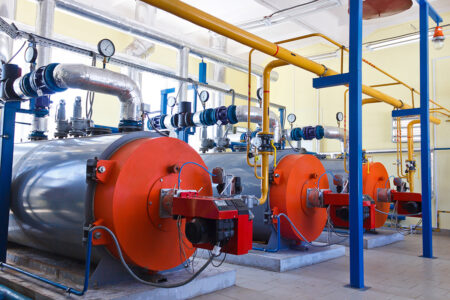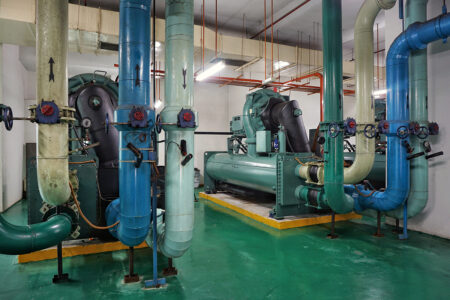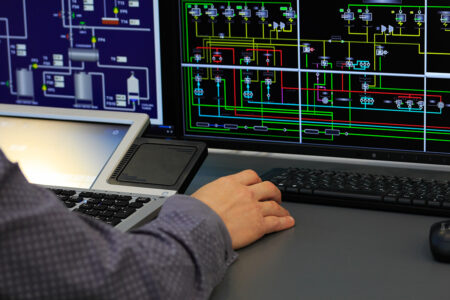INSIGHTS | November 16, 2021
So, You Want to Improve Your Mechanical Room?
We know what it’s like: your mechanical room has a laundry list of updates, upgrades, replacements, nice-to-haves, and a couple of blue-sky projects. The next budget cycle is ahead of you and it’s time to face the inevitable: how to improve your mechanical room. There are dozens of ways you may approach this decision. Because every HVAC setup and requirements differ from facility to facility, it’s important to keep your priorities clear. But regardless of which equipment you’re tackling or what “improvements” mean to you, we always recommend taking an energy -efficient approach to improve your mechanical room. Here’s why.
The energy-efficient approach to HVAC
Today, more and more companies have corporate commitments to sustainability or increasing city or state mandates to decrease carbon emissions. The pressures of these requirements have direct impacts on the teams managing buildings and facilities across the US.
HVAC represents 40%+ of a commercial building’s energy use, so this area of building management is one of the best ways to target reducing energy use and carbon emissions. And since upgrading this type of equipment could be a 20-year investment, it’s important to take strong steps toward a successful, long-term outcome, especially in the face of a world that is increasingly penalizing businesses for maintaining outdated, inefficient equipment.
In addition to improving sustainability and carbon reduction, energy efficiency solutions also provide other benefits:
- Project cost subsidized by utility incentives
- Decrease energy use – and corresponding operating costs
- Retrofit or replace end-of-life equipment with more energy-efficient equipment
- Improve system operations
- Improve space temperature control
- Support sustainability goals
Any equipment replacement typically improves a mechanical room. But replacing or retrofitting with efficient equipment and leveraging available utility incentives can make a big difference between standard project outcomes and long-lasting benefits that can meet multiple goals. This is the primary reason why energy efficiency measures are generally the best option for improving mechanical rooms.
Project options for mechanical room improvements
HVAC improvements can vary widely depending on your existing equipment, the age of that equipment, your facility team, industry, the size of a building or campus, and more. However, there are a few typical projects available to most facilities that deliver strong efficiency, sustainability, and financial benefits.

Boiler Replacement
Boiler replacement is an efficiency option we see being implemented at facilities of all industries, but particularly in healthcare and manufacturing. We often find an aging steam plant in a facility that no longer has a use for steam or that the small, remaining steam use can be eliminated with alternate equipment. The steam plant can be replaced with a high-efficiency condensing boiler system resulting in significant savings. Steam distribution systems with higher thermal losses, condensate return losses, or steam trap failures are very inefficient compared to condensing boilers/hot water systems and other efficiency options such as gas-fired instantaneous water heaters.
Other facilities may still have a requirement for steam, but the steam requirement has been significantly reduced over the years and the existing plant is oversized. Installation of a “right-sized” boiler plant with efficient controls can be an effective efficiency upgrade.

Chiller Plant Improvements
Chillers, like boilers, are big-ticket items and there is a tendency to continue using inefficient and near end-of-life equipment to avoid the capital cost of replacement. Some chillers such as single-stage steam absorption chillers or chillers that are 20-year-old or more will make chilled water at two to three times the cost of a new efficient electric chiller.
Over time, and especially with changing operating personnel, it is common to have a chilled water system that may have been originally set up for efficient operation become very inefficient. Control systems have degraded and there are issues with excessive cooling tower fan operation, primary/secondary chilled water bypass flow that de-rates chiller capacity, condenser water flow that is less than design flow resulting in degraded chiller efficiency are some of the issues that we have seen.
A Life Cycle Analysis comparing the operation of the existing chiller plant with higher energy and maintenance costs to an upgraded chiller plant with new efficient chiller and controls, (bought down by utility incentives), is a way to make informed decisions regarding investing in the chiller plant.

Air Handling Unit (AHU) Retrofits
One of our favorite retrofits for air handlers is to replace large belt-driven AHU fans with fan arrays. For this type of project, we cut out a traditional, belt-driven fan and replace it with multiple smaller, ECM-driven fans. This project provides more efficiency but, sometimes more important to the facility in question, greater redundancy. Instead of relying on a single fan – meaning if the belt breaks or the fan goes down, you’re dead in the water – multiple other fans can ramp up if one fan fails and give you time to fix the problem without losing function on the entire AHU.

Before: Removing the original fan | After: Fan wall with multiple, smaller fans.
Supplemental controls
And last, but certainly not least, adding controls is one of the best ways to comprehensively improve a mechanical room. Variable Frequency Drives, (VFDs), are an easy entry point for an HVAC system that doesn’t have many integrated controls. Many times, system operation can be made more efficient with the installation of VFDs and associated controls to control individual pumps and fans. Larger operations will want to move beyond just VFDs to consider full-scale building automation systems. A Building Automation System (BAS) can provide sophisticated control strategies that include optimum start/stop, scheduling, temperature set back, and demand control ventilation. Companies with emission reduction goals or sustainability requirements should strongly consider whether they are leveraging building controls to the best of their ability.
What’s next for your mechanical room?
One-off projects are a great way to make incremental improvements to your mechanical room. But take a step back and consider an integrated comprehensive approach that would maximize utility incentives. What could be accomplished with a comprehensive approach focused on both optimal operations and energy efficiency? Design/build energy efficiency companies such as Mantis will do the upfront legwork to define the opportunities in terms of savings, costs, and utility incentives so you can make informed decisions before making investments.






